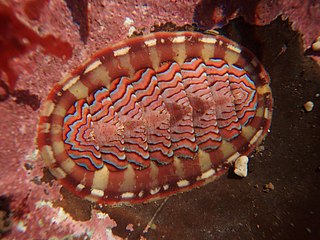
Chitons are marine molluscs of varying size in the class Polyplacophora, formerly known as Amphineura. About 940 extant and 430 fossil species are recognized.

Ischnochiton is a genus of polyplacophoran mollusc.

Onithochiton is a genus of chitons in the subfamily Toniciinae of the family Chitonidae, which is distributed from Australia and New Zealand to South Africa.

Notoplax is a genus of chitons in the family Acanthochitonidae.

Mopalia spectabilis, commonly known as the red-flecked mopalia, is a species of chiton.

Tonicella is a genus of chitons known as the lined chitons.

Tonicella lokii, commonly known as the flame lined chiton or Loki's chiton, is a chiton in the lined chiton genus Tonicella.

Micromelo is a genus of sea snails, bubble snails, marine opisthobranch gastropod mollusks in the family Aplustridae.

Acanthopleura granulata, common name the West Indian fuzzy chiton, is a medium-sized tropical species of chiton. This type of chiton's activity does not depend on spring-neap oscillations leading to lower locomotion loss. Its morphology is different from usual chitons as it has a fifth valve, which is split into halves.
The subradular organ is a sensory organ below the grinding mouthparts (radula) of some molluscs, specifically the chitons. This organ is involved in chemoreception - that is, in judging the nature of food or the substratum. In this sense, it can be considered a 'smell' or 'taste' organ; food is sensed before each stroke of the radula. Nerve cells from the subradular organ join into the buccal nerves.

Acanthochitonina is a suborder of polyplacophoran mollusc comprising both fossil and extant species.

Hanleya is a genus of polyplacophoran molluscs known from Oligocene and Miocene fossils; it is represented today by a number of species including H. sinica Xu 1990 (China), H. brachyplax (Brazil) and H. hanleyi Bean in Thorpe, 1844 (Chile), which feeds on sponges.

Stenoplax is a genus of polyplacophoran molluscs in the family Ischnochitonidae.
Spongioradsia is a genus of polyplacophoran molluscs. Spongioradsia became extinct during the Oligocene period.

Tonicia is a genus of chitons in the subfamily Toniciinae of the family Chitonidae.

A girdle is part of the anatomy of a chiton, one class of marine mollusks, the class Polyplacophora. The shell of a chiton consists of eight valves which articulate with one another. The girdle is a strong but flexible structure that in most cases encircles the plates, holding them all together.

Lepidochitona cinerea, known by the common names common chiton or gray chiton, is a species of chiton, a marine polyplacophoran mollusc in the family Tonicellidae.

Tonicella insignis, the white-lined chiton, or red chiton, also known as the hidden chiton, belongs to the Tonicellidae family in the class Polyplacophora, and the phylum of Mollusca. Its body length of T. insignis is around 5 cm.














